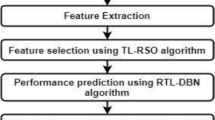Abstract
Educational data mining (EDM) has emerged as a research area in recent years for researchers all over the world from different and related research areas. The EDM obtained knowledge can be used to offer suggestions to the academic planners in higher education institutes to enhance their decision-making process. Literature has suggested various prediction models for predicting the student’s performance. This work proposes the cluster based distributed architecture for predicting the student’s performance. The proposed cluster-based distributed architecture performs the prediction with clustering through Bayesian fuzzy clustering, feature extraction through Kernel-based principal component analysis, and prediction through the proposed Lion–Wolf based deep belief network (LW-DBN). The proposed architecture uses the LW algorithm to find the optimal weights for the DBN. The experimentation of the proposed work is done by collecting a real-time database and measuring the prediction performance through the mean square error (MSE) and root MSE (RMSE). The proposed LW-DBN model has achieved lower error performance than other models with MSE and RMSE values of 0.222606 and 0.050435, for the database.






Similar content being viewed by others
References
Bharara, S., Sabitha, S., Bansal, A.: Application of learning analytics using clustering data mining for students’ disposition analysis. Educ. Inf. Technol. 2017, 1–28 (2017)
Wook, M., Yusof, Z.M., Nazri, M.Z.A.: Educational data mining acceptance among undergraduate students. Educ. Inf. Technol. 22(3), 1195–1216 (2017)
Baker, R.S.: Educational data mining: an advance for intelligent systems in education. IEEE Intell. Syst. 29(3), 78–82 (2014)
Hussain, M., Al-Mourad, M., Mathew, S., Hussein, A.: Mining educational data for academic accreditation: aligning assessment with outcomes. Glob. J. Flex. Syst. Manag. 18(1), 51–60 (2017)
Kotsiantis, S.B.: Use of machine learning techniques for educational proposes: a decision support system for forecasting students grades. Artif. Intell. Rev. 37(4), 331–344 (2012)
Barber, R., Sharkey, M.: Course correction: using analytics to predict course success. In: Proceedings of the 2nd International Conference On Learning Analytics and Knowledge, pp. 259–262 (2012)
Polyzou, A., Karypis, G.: Grade prediction with course and student specific models. In: Pacific-Asia Conference on Knowledge Discovery and Data Mining, pp. 89–101 (2016)
Almutairi, F.M., Sidiropoulos, N.D., Karypis, G.: Context-Aware recommendation-based learning analytics using tensor and coupled matrix factorization. IEEE J. Sel. Top. Signal Process. 11(5), 729–741 (2017)
Liu, L., Sun, L., Chen, S., Liu, M., Zhong, J.: K-PRSCAN: a clustering method based on PageRank. Neurocomputing 175, 65–80 (2016)
Ferranti, A., Marcelloni, F., Segatori, A., Antonelli, M., Ducange, P.: A distributed approach to multi-objective evolutionary generation of fuzzy rule-based classifiers from big data. Inf. Sci. 415, 319–340 (2017)
Yahya, A.A.: Swarm intelligence-based approach for educational data classification. J. King Saud Univ. Comput. Inf. Sci. (2017). https://doi.org/10.1016/j.jksuci.2017.08.002
Cortes, C., Vapnik, V.: Support-vector networks. Mach. Learn. 20(3), 273–297 (1995)
Domingos, P., Pazzani, M.: On the optimality of the simple Bayesian classifier under zero-one loss. Mach. Learn. 29(2), 103–130 (1997)
Nürnberger, A., Pedrycz, W., Kruse, R.: Data mining tasks and methods: Classification: neural network approaches. In: Handbook of Data Mining and Knowledge Discovery, New York, pp. 304–317 (2002)
Costa, E.B., Fonseca, B., Santana, M.A., de Araújo, F.F., Rego, J.: Evaluating the effectiveness of educational data mining techniques for early prediction of students’ academic failure in introductory programming courses. Comput. Hum. Behav. 73, 247–256 (2017)
Asif, R., Merceron, A., Ali, S.A., Haider, N.G.: Analyzing undergraduate students’ performance using educational data mining. Comput. Educ. 113, 177–194 (2017)
Kuppusamy, V., Paramasivam, I.: Integrating WLI fuzzy clustering with grey neural network for missing data imputation. International. J. Intell. Enterp. 4(1–2), 103–127 (2017)
Romero, C., López, M.I., Luna, J.M., Ventura, S.: Predicting student’s final performance from participation in online discussion forums. Comput. Educ. 68, 458–472 (2013)
Wolff, A., Zdrahal, Z., Herrmannova, D., Knoth, P.: Predicting student performance from combined data sources. In: Alejandro, P.-A. (ed.) Educational data mining, pp. 175–202. Springer, Cham (2014)
Guarín, C.E.L., Guzman, E.L., González, F.A.: A model to predict low academic performance at a specific enrolment using DATA mining. IEEE J. Learn. Technol. 10(3), 119–125 (2015)
Chen, D., Chen, Y., Brownlow, B.N., Kanjamala, P.P., Arredondo, C.A.G., Radspinner, B.L., Raveling, M.A.: Real-time or near real-time persisting daily healthcare data into HDFS and ElasticSearch Index inside a big data platform. IEEE Trans. Ind. Inf. 13(2), 595–606 (2017)
Glenn, T.C., Zare, A., Gader, P.D.: Bayesian fuzzy clustering. IEEE Trans. Fuzzy Syst. 23(5), 1545–1561 (2015)
Ebied, H.M.: Feature extraction using PCA and Kernel-PCA for face recognition. In: Proceedings of 8th International Conference on Informatics and Systems (INFOS), Cairo, Egypt, pp. 72–77 (2012)
Ramanathan, A.G., Khalid, M., Swarnalatha, P.: Student performance prediction model based on Lion-Wolf neural network. Int. J. Intell. Eng. Syst. 10(1), 114–123 (2017)
Vojt, B.: Deep neural networks and their implementation. Thesis, Charles University in Prague (2016)
Yazdani, M., Jolai, F.: Lion optimization algorithm (LOA): a nature-inspired metaheuristic algorithm. J. Comput. Des. Eng. 3(1), 24–36 (2016)
Mirjalili, S., Mirjalili, S.M., Lewis, A.: Grey wolf optimizer. Adv. Eng. Softw. 69, 46–61 (2014)
Montana, D.J., Davis, L.: Training feedforward neural networks using genetic algorithms. Proc. IJCAI 89, 762–767 (1989)
Author information
Authors and Affiliations
Corresponding author
Rights and permissions
About this article
Cite this article
Ramanathan, L., Parthasarathy, G., Vijayakumar, K. et al. Cluster-based distributed architecture for prediction of student’s performance in higher education. Cluster Comput 22 (Suppl 1), 1329–1344 (2019). https://doi.org/10.1007/s10586-017-1624-7
Received:
Revised:
Accepted:
Published:
Issue Date:
DOI: https://doi.org/10.1007/s10586-017-1624-7




